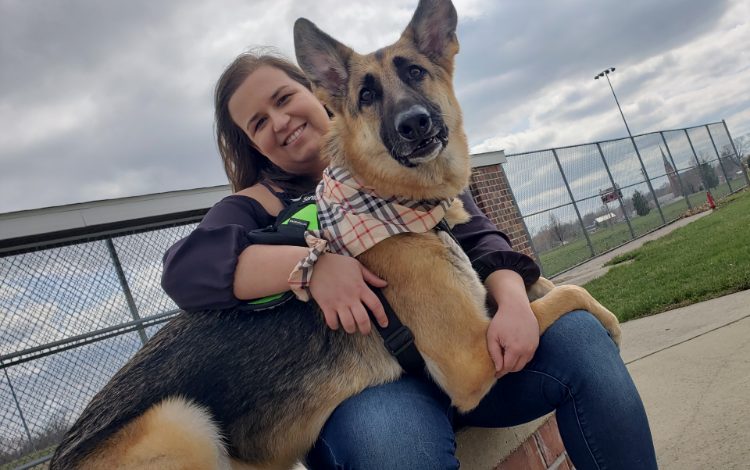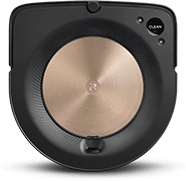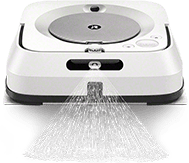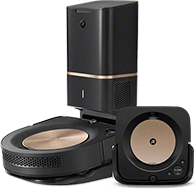Robot Vacuums, Physical Disabilities, and Service Dogs: A Love Story
It all started with a rescue dog named Loki.
Megan, the creator of the popular TikTik account Saved by a Rescue, was diagnosed with a physical disability that neither medicine nor physical therapy could resolve. Megan could use crutches or a wheelchair, but her workplace at the time wasn’t Americans with Disabilities Act (ADA)-compliant, giving her only one option. Her doctor recommended an assistance dog. But getting a trained service dog proved harder than expected.
The cost of a service dog is up to $50,000 upfront. And healthcare insurance doesn’t cover the cost. There is a waiting list, and hiring a professional dog trainer to train your dog is expensive. To get a service dog, some people resort to fundraising through a GoFundMe page, personal loans, or another form of financial assistance. Megan thought there should be a better way. She couldn’t afford a service animal trained from an official program, but she didn’t need one. She already had her rescue pup, Loki, ready to take on the challenge.
Service dog training with Saved by a Rescue
“The catalyst was my health took a downturn, and I needed a service dog,” Megan explained. “I had rescued Loki from a shelter. At that point, Loki and I had been working together for about a year and a half on obedience and socializing to overcome his difficulties coming out of the shelter. I had him evaluated by another trainer, and the trainer said he would be a perfect candidate [for a service dog].” Despite her limited mobility, Megan decided to take on the responsibility of the extensive training it took to get Loki ready to become a service dog. Loki was her key to independence, and in her effort to get him ready for the job, she found that the journey gave her independence in more ways than one.
Megan set out to become as knowledgeable as possible on training service dogs. After endless hours of reading books, taking seminars, and watching videos, Loki was ready to become a service dog. Megan said, “If this worked so well for Loki, I need to research this more!”
After her experience training Loki, she felt ready to help other people who couldn’t afford a $50,000 service dog. That’s when she started Saved by a Rescue, where she trains rescue dogs to become service animals. Instead of paying tens of thousands for a trained service dog, her customers only pay for dog food, vaccinations, veterinary care, and a small cost for Megan’s training time.
“With any rescue dog, you must be cognizant of traumas they’ve gone through,” Megan said. “But trauma can be worked through.” Megan specializes in helping rescue dogs move through the events that led them to the shelter and prepare them for a life of service as a service dog with a human of their own!
When talking about her passion for training rescue dogs to become service dogs, she said, “This is something I think needs to be done: rescuing dogs out of a shelter or in a different situation and training them to be service dogs for other people who need it, who can’t afford a $50,000 dog.”
What do service dogs do?
Loki helps Megan with everyday things that she isn’t able to do because of her disability, like:
- Supports specific tasks like getting water or medicine.
- Helps her out of bed.
- Helps her walk.
- Alerts her when her heart rate rises.
- Deep pressure therapy to lower her heart rate.
- Gives her a 30-minute heads up when a migraine is impending.
Scent training got Loki ready to alert Megan when a migraine or heart rate issue would be happening. To do this, she would swab her cheek when she had a migraine, or her heart rate would spike. Loki could smell the difference in her body chemistry between normal Megan, high heart rate Megan, and migraine Megan. After the scent training, he could give her a half-hour heads-up when a migraine was approaching. This gives her enough time to prevent the issue from ever starting!
What are the service dog specialties?
Service dogs can specialize in supporting different types of impairments.
There are:
- Autism service dogs
- Seeing eye dogs
- Psychiatric service dogs
- Guide dogs
Therapy dogs and emotional support animals, while essential to their owners, are not considered service dogs. And as such, support animals are not granted the same public access rights.
As you can expect, training to become a service dog goes far beyond obedience training.
Megan explained her relationship with Loki as a pet and a service dog. “He just never leaves my eyesight. He’s just kind of watching. He’s able to completely be a normal dog. He can go play and sleep, but he’s always kind of on duty. It’s not something that I made him do. It’s something he genuinely wants to help with.”
What breed of dog can be a service animal?
You can use your dog as a service animal if it has the right temperament and training, but can your baby pupperoni and cheese MinPin be your service animal? The answer to that is a big fat, “it depends.” Don’t you hate that answer?
The breed of dog you choose as your service dog depends on your ailment. For example, if you need a service dog that can alert you to an impending diabetic issue, any size dog could work. Whether you have a toy poodle or a golden retriever, either breed would work for this type of service.
However, if you have a physical impairment that requires physical support from your service dog, you will need a larger dog breed that can handle your size and weight. Consider a German Shepherd, Labrador Retriever, or another large breed.
Talk to an expert before starting training if you’re considering using your own dog as your service dog.
How does Megan support people with impairments?
When Megan isn’t training service dogs, she is on TikTok talking to people who need her support. She said, “Chronic illness and chronic pain is something I think a lot of people deal with in their everyday life.” They need someone to talk to who has been through it.
Whether they have questions about ADA compliance, emotional support because someone made fun of them, or questions about their service dog, she is there to be a sounding board for them.
Megan trains dogs for people with PTSD (post-traumatic stress disorder), Type 2 Diabetes, ADHD, depression, anxiety, and POTS, among other mental illnesses and ailments. She trains their dogs for mobility support and medical alerts. She is inspired to help because of her difficulty at the beginning of her journey to get a service dog. She didn’t know how she could afford a service dog, what to expect once she did have one, or how people would treat her. Now, she can use this experience to help other people in similar circumstances move through the journey with support from someone who has been there.
Household cleaning tools that support the independence of people with disabilities
Before Megan utilized robots for household chores, she would start cleaning and get lightheaded because her heart rate would spike or the chronic pain would become too much. Loki would come over and say, “Hey, ma. You gotta sit down,” but in his own doggy way. When housecleaning her living room should have taken thirty minutes, but it became an all-day chore, she knew she needed to find a solution.
You can’t just bust out your cleaning products and cleaning tools to clean up messes when you have chronic pain. Now, imagine spring cleaning! That’s out of the question when a thirty-minute sprint cleaning is too much. Instead, you need to have a heavy-duty plan.
“With disabilities, life takes much more planning,” Megan said. “You have to plan around your disability and what you can and can’t do.” People with disabilities need the right combination of cleaning hacks and gadgets like robotic vacuums and steam mops to do household chores without constant pain.
When it comes to cleaning, it’s common for people with disabilities to look for the right combination of reacher/grabber tools, and cordless vacuums (so they don’t need to bend over to plug and unplug cords), lightweight vacuums, and sweepers and dustpans with long handles. But now, Megan uses Steve and Carli her Roomba® robot vacuum cleaner, and Braava® robot mop. (Aren’t those the cutest robot vacuum names?) They do the hard work of cleaning up the floors covered in rescue dog fur and saliva while she spends her time doing what she loves: training service dogs.
Megan said, “They are so great for people with disabilities! The amount of time you save and energy you save, the robotic vacuum and mop improve the quality of life of my dogs, too! I used to be able to clean my hard floors once a week, and now they’re clean every day.”
On top of the benefits of a clean house, her dogs have learned to become friends with her robot cleaners. The first week she had the robot vacuum and mop, she worked with the dogs on desensitizing them to the robot. Now, her little robot maids can bump into the dogs, and they don’t even notice.
Robot cleaning devices save people with disabilities time from the grime – but also money. Where they may have had to pay for a cleaning service before, they now only need to pay a one-time price, and their homes stay clean.
How to connect with Megan from Saved by a Rescue
We can thank Loki for being the guide dog on the journey to Saved by a Rescue. Thanks to him, Megan now helps people with physical disabilities and mental disabilities improve their quality of life with a service dog.
“I just like animals, and I try and be as fair with them as I would any human,” Megan said.
Connect with Megan on TikTok or Instagram to learn more about service dogs, therapy dogs, and emotional support animals. You can also support her through her Saved by a Rescue Amazon Wishlist.
Additional resources to learn more about service dogs
Helpful websites:
- Know your Americans with Disabilities Act (ADA) rights
- Assistance Dogs International
- International Association of Assistance Dog Partners (IAADP)
Dog trainers:
- Coach Carlos (@coaching4paws)
- Vic with Divine Canine Dog Training (@divinecaninedogtraining)
- Abbey Johnson (@thepositivechihuahuas)
- Norka (@norka_dogguru1)
Service dog Professional Training
- Marie – Service Dog User, Trainer, and Educator (@mariesshepherds)
- Lyhra – Service Dog User, Trainer, and Educator (@superherok9s)
- Shelly – Service Dog User, Ethologist, Behaviorist, and Dog Trainer (@thejunglenook)
- Kristy Wyckoff – Dog Trainer and Service Dog User (@kodasclassroom)
Guide dog education
- Bella & O’Hara – Guide Dog Team (@my.eyes.ohara)
- Servicemutt & Co – Service Dog User and Educator (@servicemuttandco)
- Esther – Service Dog User and Educator (@chronicallyannoyed)
- Hanna Avery – Service Dog User and Educator (@my.beautiful.disaster)
- Candace – Guide Dog User and Educator (@candaceandclea)





